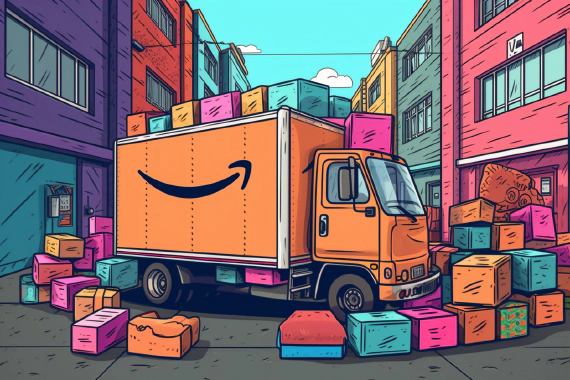
What is an Amazon RMA ID?
Amazon RMA ID What is an Amazon RMA ID? An Amazon RMA (Return Merchandise Authorization) ID is a unique …


According to surveys, most Amazon sellers make 15% or more profit margin, after all expenses are taken into account. However, there are a number of Amazon sellers who are not profitable. A survey of 1,000 Amazon sellers found that 20% of them were not profitable.
There are a number of reasons why some Amazon sellers are not profitable. One reason is that they may be selling products that are not in high demand.
Another reason is that they may be selling products that have low profit margins. Finally, some Amazon sellers may be spending too much money on advertising and other expenses.
The answer to this question depends on the costs associated with the product you are selling. Generally speaking, a good profit margin for Amazon sellers is around 30%. Keep in mind, you have to calculate the fees that Amazon takes, plus what ever costs it took you to acquire/manufacture the product plus ship it.
So for example, if you had a $100 product costs, and sold it for $130, you might naively think that you have a 30% profit. However, if Amazon took more than $30, you actually lose money. It’s easy for fees to add up if you aren’t tracking them on a daily basis. Amazon fees can change, and they are different for each product category you sell in.
For example, the fees for small electronics are very different from the fees for books.
Additionally, Amazon has a very complex system of refunds and customer complaints that can eat into your profits. The fees for these matters are separate from the fees for selling the product, so it’s important to track them separately.
When you sell a product on Amazon, you are responsible for the customer experience. Amazon customers are very demanding, and will readily return a product or leave a negative review if they are not satisfied.
If a customer returns a product, you have to pay the return shipping. You also have to pay Amazon a 15% restocking fee. In addition, Amazon may give the customer a refund on their original shipping costs. So if you sold a product for $100, and the customer returns it, you may end up paying $115 in fees. And that’s if everything goes smoothly!
If a customer leaves a negative review, this can have a major impact on your sales. Amazon customers trust reviews, and are very unlikely to buy a product with a low star rating.
There are multiple categories of Amazon Selling fees:
Take a look at competitors in your niche, and do some basic research. Are they selling direct from a factory? If so, there’s almost no way your profit margin can match what your competitor is selling. They can underprice you at will.
Do they have a brand name? If so, you’ll need to spend some time and money building up a brand name for your own products.
Do they have a huge marketing budget? If so, you’ll need to find ways to get Free advertising and press.
Do they have a patent? If so, you’ll need to be very careful to avoid infringing on their patent.
Do they have a well-known name? If so, you’ll need to be very careful to avoid being confused with them.
Do they have a license to sell a product? If so, you’ll need to be very careful to make sure you’re not selling it without a license.
Do they have a trademark? If so, you’ll need to be very careful to avoid infringing on their trademark.
Do they have a copyright? If so, you’ll need to be very careful to avoid infringing on their copyright.
Do they have a trade secret? If so, you’ll need to be very careful to avoid infringing on their trade secret.
Do they have a contract with a supplier? If so, you’ll need to find your own supplier that doesn’t have an exclusive contract.
Think about what makes your product unique. Are you simply putting a brand on an existing product that is saturated on Amazon? Why would a customer buy your product with few reviews, over one exactly the same with 1,000s?
This is called your value proposition, and it’s the most important thing to think about when starting to sell on Amazon.
Some factors to consider when thinking about your value proposition are:
Your value proposition is what will make your product stand out from the crowd and convince customers to buy from you instead of your competitors.
There are a few steps you will need to take in order to calculate your Amazon profit margin.
First, you will need to calculate your net sales. This is your total revenue from Amazon sales minus any refunds, returns, or other adjustments.
Next, you will need to calculate your cost of goods sold (COGS). This includes the cost of the products you sold, the cost of shipping, and any other direct costs associated with fulfilling your orders.
Finally, you will need to subtract your COGS from your net sales to get your gross profit. From there, you can divide your gross profit by your net sales to get your profit margin.
Keep in mind that your profit margin will vary depending on the prices of the products you sell, your shipping costs, and other factors. However, this should give you a good starting point for calculating your Amazon profit margin.
It’s not recommended that you do these calculations yourself. Find a tool such as Hivearchive that can automatically download your order history, allow you to enter your cost of goods, and then give you minute by minute profit analysis in a single dashboard. You want to automate the parts of your business that are time consuming and error prone. This is a quick and easy way to do this.
Return on Investment or (ROI) is a performance measure used to evaluate the efficiency of an investment or to compare the efficiency of a number of different investments. ROI tries to directly measure the “return” of an investment.
There are a number of different ways to measure ROI, but the most common is to divide the net profits of the investment by the total costs of the investment.
For example, if you spend $100 on an advertising campaign and it generates $200 in sales, your ROI would be 200% ((200-100)/100).
ROI is a popular metric because it is easy to calculate and understand.
The answer to this question depends on your goals and objectives. If your goal is to simply make more money than you spend, then any ROI above 0% is good.
However, if your goal is to make as much money as possible, then you will need to compare your ROI to other investment opportunities. For example, if you could make a 10% ROI by investing in stocks, but a 20% ROI by investing in real estate, you would probably choose to invest in real estate.
Retail Arbitrage is the practice of buying products at a low price and selling them at a higher price. This can be done online or in brick and mortar stores.
The key to successful retail arbitrage is to find products that are in high demand and have a low supply. This can be done by following trends, monitoring social media, or using a tool like Amazon to find products with high sales and low prices.
Once you have found a product that you think you can sell for a higher price, you will need to purchase it and list it for sale. The most important thing to remember is that you need to price your product competitively. If your price is too high, no one will buy it. If your price is too low, you will not make a profit.
Net profit is the total revenue from the sale of a product or service, minus the cost of goods sold, operating expenses, interest, and taxes.
For example, if a company has total revenue of $100,000 and total expenses of $80,000, the company’s net profit would be $20,000.
Net profit is also sometimes referred to as “net income” or “net earnings.”
Navigate to your Seller Central homepage, and on the left-hand side, hover over “Reports”. In the drop-down menu, select “Fulfillment”, and then “Inventory Health”.
On the “Inventory Health” page, you will see a table that shows all of your FBA inventory, as well as how many units have sold in the last 30 days.
To calculate your FBA fees, you will need to know the following:
You can use the Amazon FBA Fee Calculator to calculate your fees.
To find your FBA sales rank, log into your Amazon Seller Central account. On the left-hand side, hover over “Reports”. In the drop-down menu, select “Fulfillment”, and then “Inventory Health”.
On the “Inventory Health” page, you will see a table that shows all of your FBA inventory, as well as your sales rank for each product.
Increasing profit margins for your Amazon FBA business might sound challenging, but with these strategic steps, it can be achieved.
Source Products Cost-Effectively: Finding suppliers that offer better prices or buying in bulk can significantly reduce the cost of goods, thus improving profit margins. Don’t forget to negotiate for the best prices and terms!
Optimize Product Pricing: Keep an eye on market trends and your competitors' pricing. You don’t always need to be the cheapest option, especially if your product offers superior quality or unique features. Use tools like Amazon’s “Match Low Price” feature to stay competitive without excessively undercutting your prices.
Improve Operational Efficiency: Streamline your business operations. Automation can play a big role in this. Consider using inventory management software, accounting tools, and automated repricing software to reduce time spent on manual tasks.
Manage Amazon FBA Fees: Be sure to understand the breakdown of FBA fees. Some fees, like storage fees, can be reduced by managing your inventory effectively to avoid long-term storage fees.
Enhance Product Listings: Optimized product listings can lead to higher conversion rates. Use high-quality images, write detailed and compelling product descriptions, and make use of the right keywords.
Customer Satisfaction: Strive for excellent customer service. Good reviews and ratings not only attract more customers but can also give you a better ranking on Amazon’s algorithm.
Expand Product Line: Diversifying your product line can spread risk and increase overall profitability. Find complementary products to your existing line to cross-sell or upsell, increasing your average order value.
By implementing these strategies, you can aim for improved profitability in your Amazon FBA business, ultimately leading to better ROI.
Amazon’s search algorithm, also known as A9, is a powerful product search engine that Amazon uses to provide customers with the most relevant product listings for their searches. Understanding how A9 works can significantly impact your product’s visibility and sales on the platform.
A9 prioritizes relevance and customer satisfaction. It assesses a broad range of factors when ranking search results, but the following are the most significant:
Product Relevance: This refers to how closely your product matches the customer’s search query. The algorithm evaluates the product title, product description, and the backend keywords. Accurately describing your product and using relevant keywords in your listing are crucial.
Customer Satisfaction and Retention: A9 considers the overall customer experience, including product quality, seller’s feedback ratings, product reviews, and order defect rate. Consistently positive reviews, high ratings, and excellent customer service will improve your product ranking.
Price: A9 also considers the price of the product. Listings with competitive prices tend to rank higher.
Sales Velocity: The number of units you sell is another significant factor. Products with high sales velocity tend to rank higher in Amazon’s search results.
Optimizing your product listings for A9 can boost their visibility and increase your sales. Here are some best practices:
Keyword Optimization: Identify relevant keywords for your product and incorporate them into your product title, description, and backend keywords. Tools like Google Keyword Planner or Amazon’s auto-suggest feature can help find suitable keywords.
Improve Product Images: High-quality images can improve click-through and conversion rates. Make sure your main image is clear, professional, and adheres to Amazon’s image requirements.
Competitive Pricing: Keeping your prices competitive can improve your sales velocity and product ranking.
Collect Reviews: Encourage customers to leave reviews on your product. More positive reviews can improve your ranking and attract more customers.
Manage Inventory: Out-of-stock products rank lower. Ensure you have adequate inventory to meet customer demand.
By understanding and optimizing for A9, you can improve your product’s visibility and increase your sales on Amazon.
Hivearchive is a comprehensive solution for Amazon FBA sellers that provides the tools you need to monitor and optimize your business. It allows you to track your seller account in real-time, providing a snapshot of your sales performance, inventory management, and profitability.
As an Amazon FBA business owner, the significance of understanding your monthly sales, profits, and overall account performance can’t be overstated. This is where Hivearchive comes in.
Hivearchive offers an automated system that ensures accurate and timely data analysis. By providing an easy-to-understand dashboard, you can track your daily and monthly sales, observe your inventory levels, and even predict future sales trends.
Understanding your profit margins is critical for making your business profitable on Amazon. With Hivearchive, you can easily calculate your ROI by taking into account all costs, including Amazon fees, shipping costs, cost of goods sold, and any other expenses.
In essence, Hivearchive offers a transparent view of your Amazon FBA business, allowing you to make data-driven decisions to improve your profit margins.
Running a successful Amazon FBA business requires strategic planning, continuous optimization, and a comprehensive understanding of your business performance. While Amazon provides a complex and dynamic marketplace for sellers, tools like Hivearchive make it easier to navigate this environment.
In the long term, the key to a successful and profitable Amazon FBA business is a combination of efficient operations, competitive pricing, outstanding customer service, and using data to drive your decisions. Automating your profit calculations and sales tracking allows you to focus more on growing your business, rather than getting stuck in the details.
So whether you’re just starting your Amazon FBA journey or you’re an experienced seller looking to optimize your business, Hivearchive can be a game-changer, helping you to maximize your profitability and ensure your business' success.

Amazon RMA ID What is an Amazon RMA ID? An Amazon RMA (Return Merchandise Authorization) ID is a unique …

Making Money by Selling on Amazon The Basics Did you know that most people selling on Amazon make about 15% …

Comprehensive Guide to Refurbished Items on E-commerce Platforms Introduction Unveiling what refurbished items …